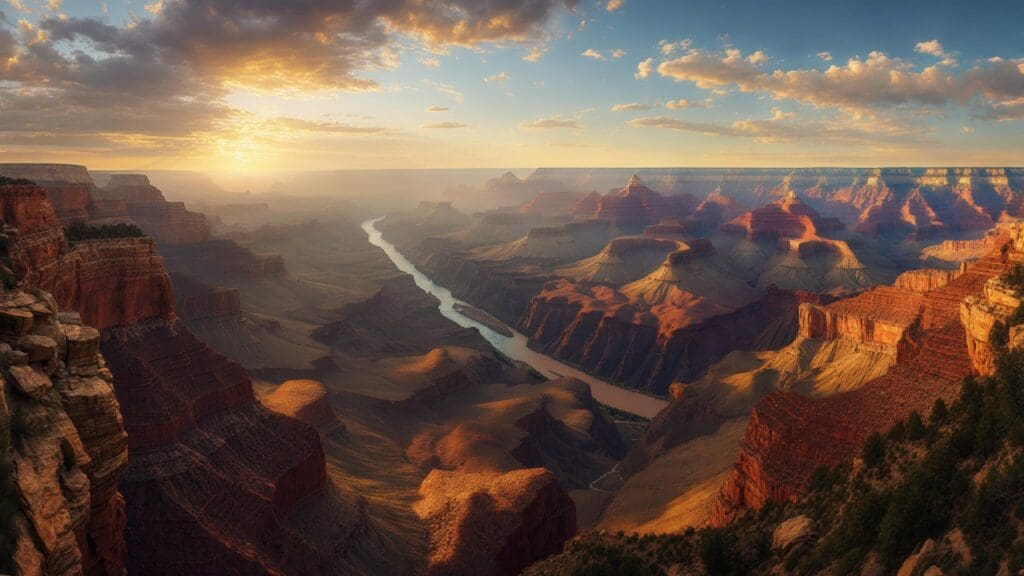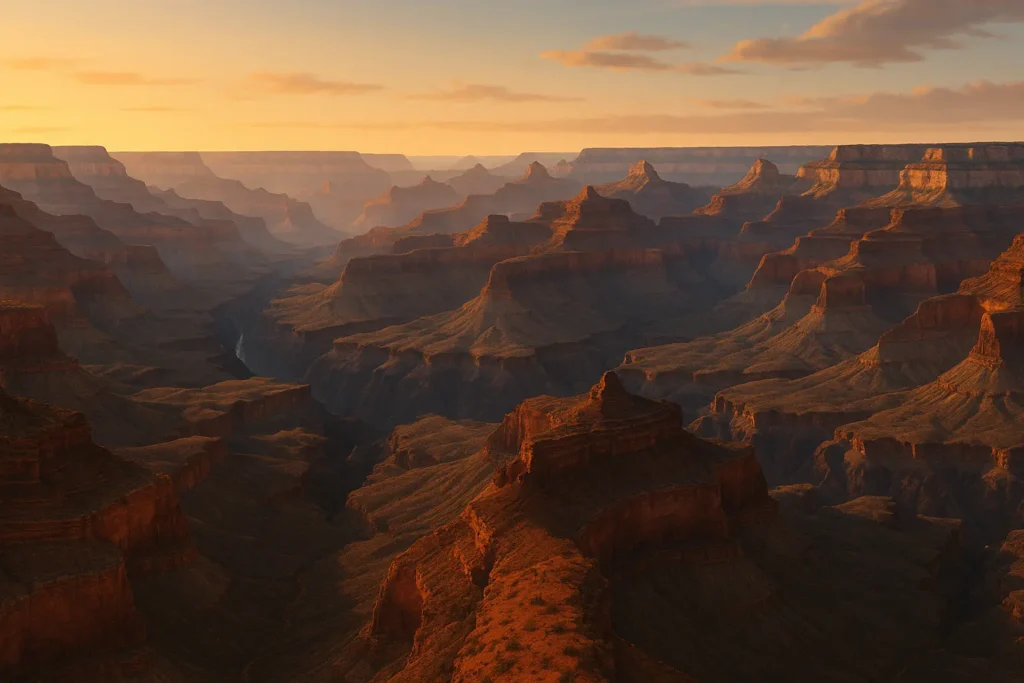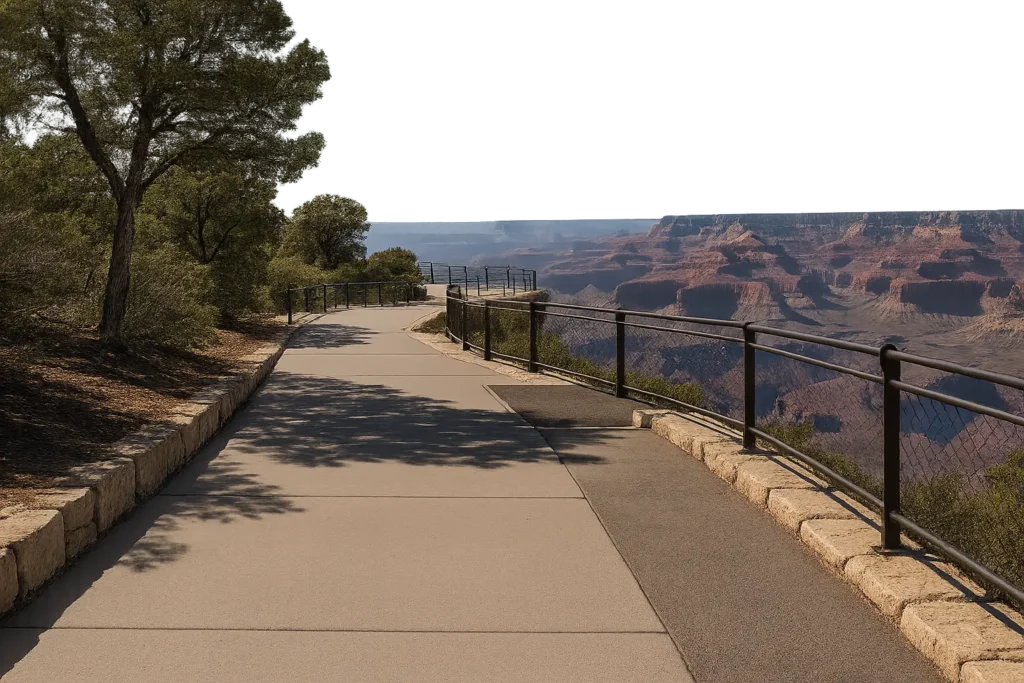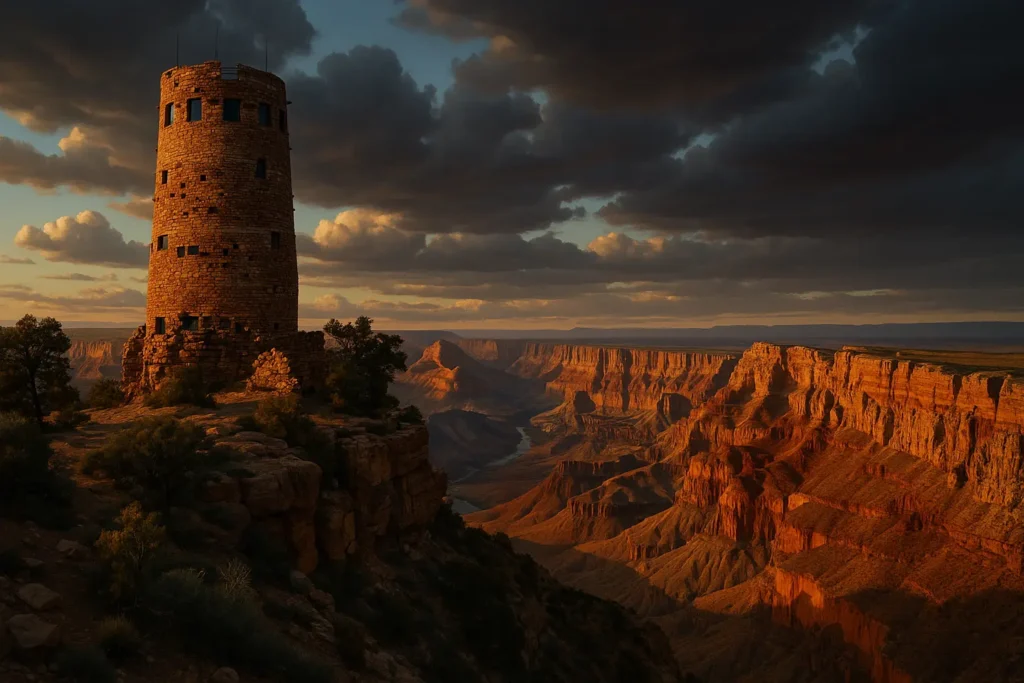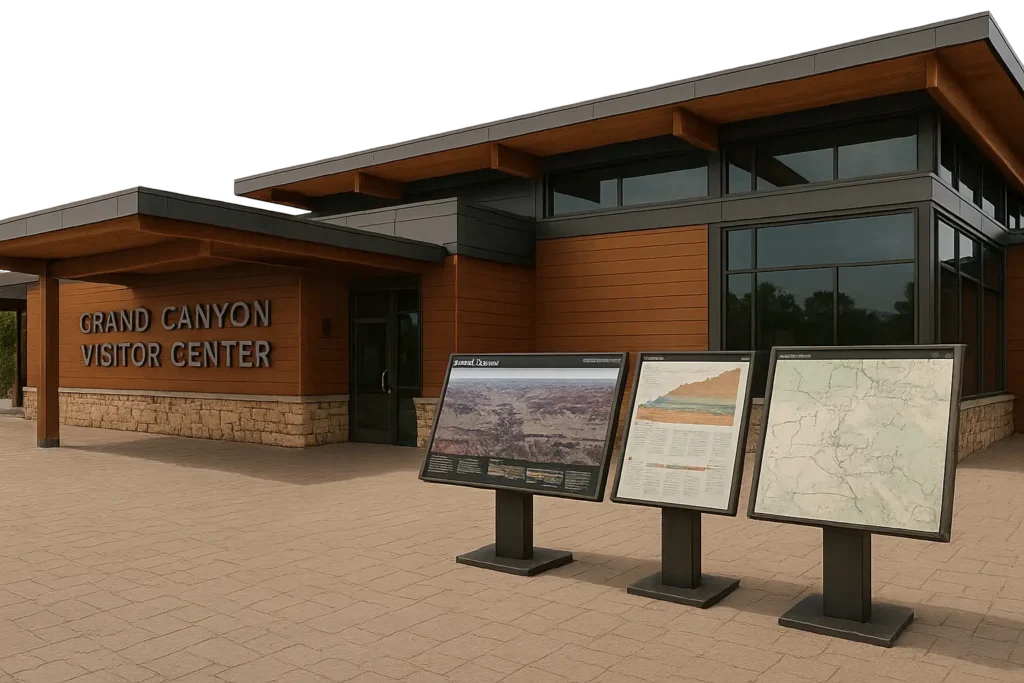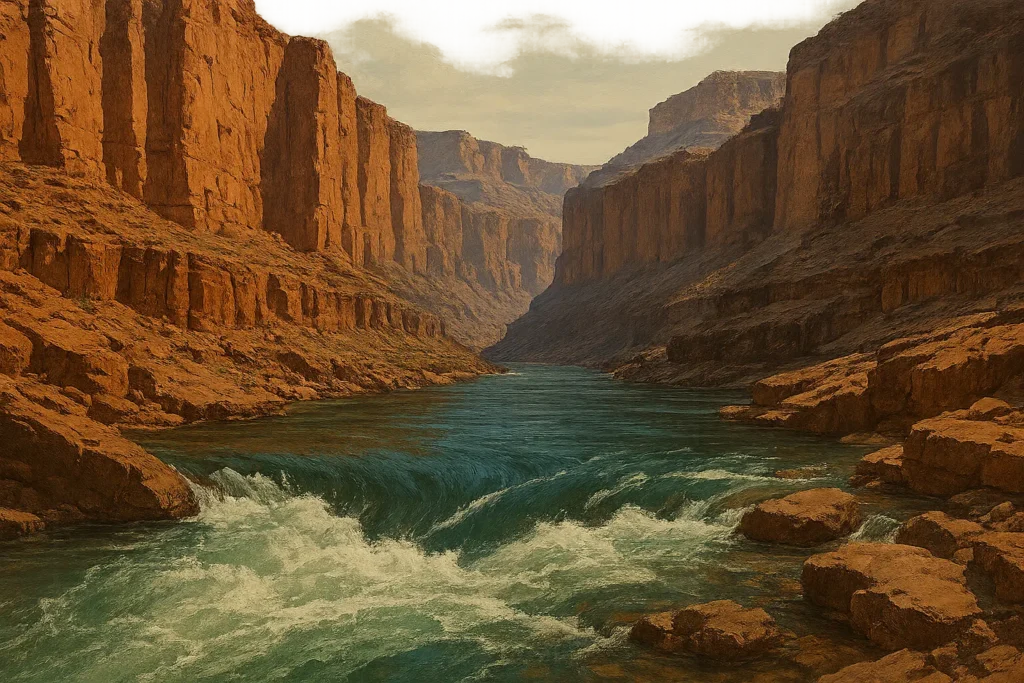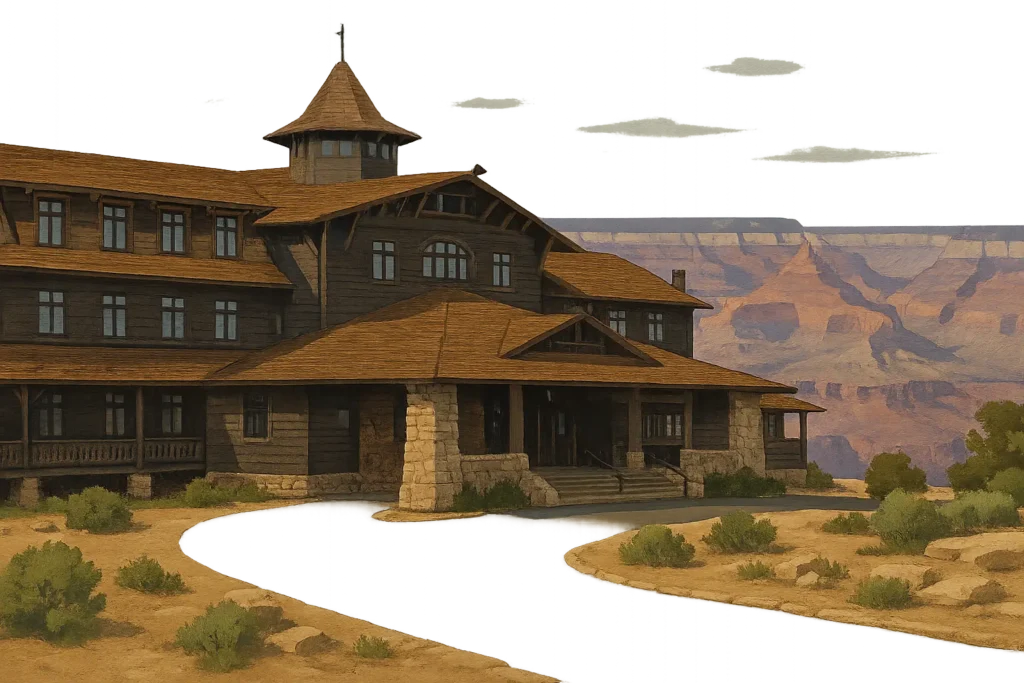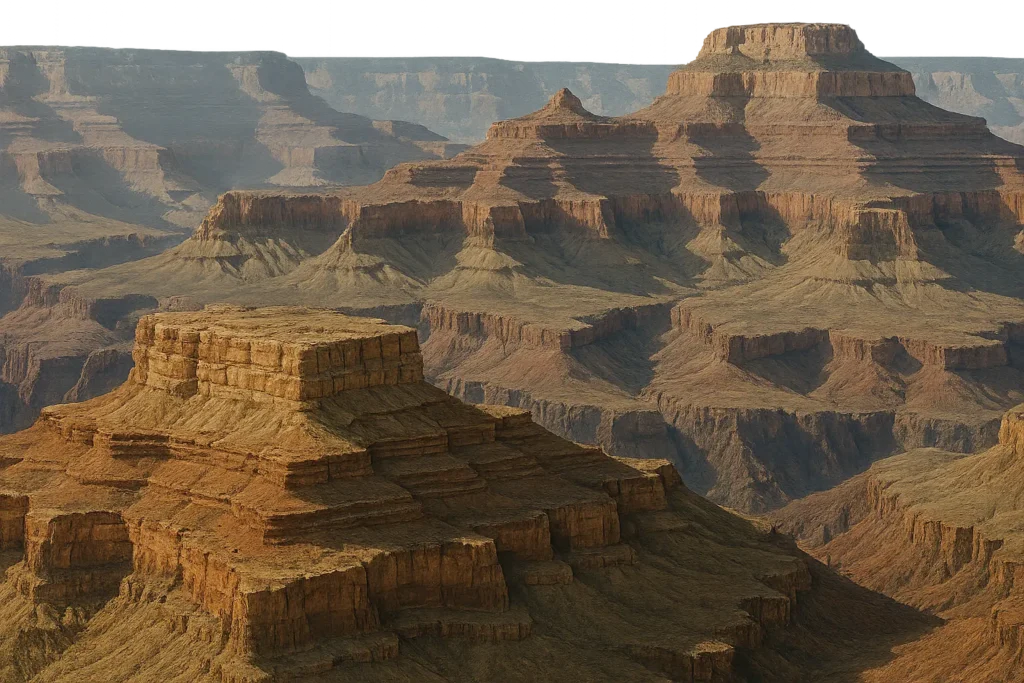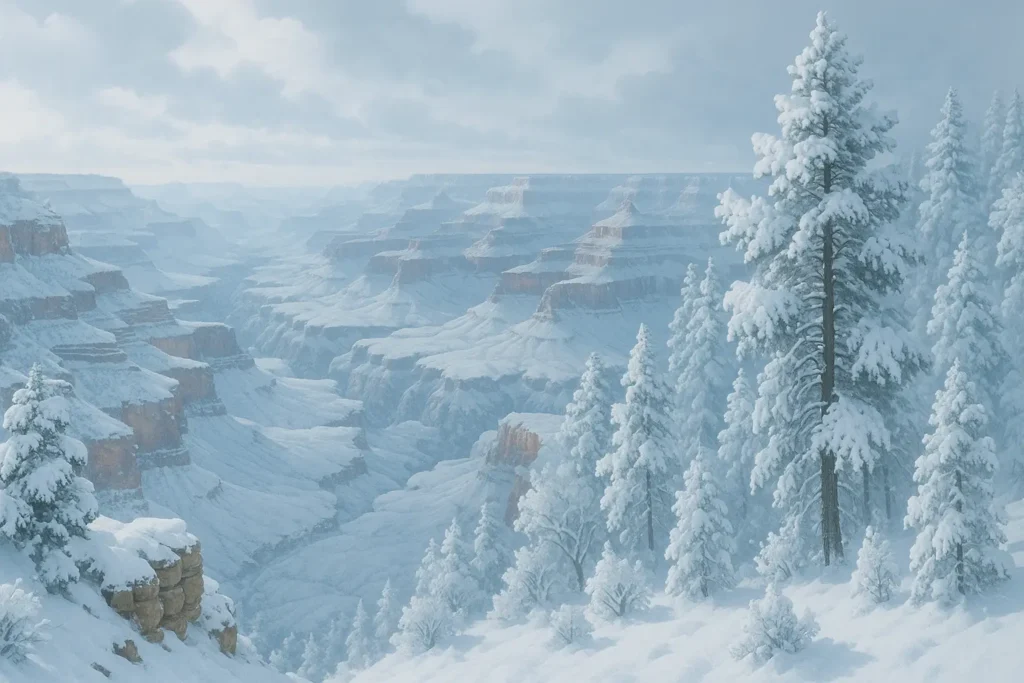Look, I get it – with nearly 5 million people visiting the Grand Canyon last year according to Earth Trekkers, you might worry about crowds. But here’s the thing I learned after my third visit: I still remember my first glimpse of the canyon’s rim like it was yesterday. Nothing – and I mean nothing – prepares you for that moment when you realize you’re staring at nearly 2 billion years of geological history carved into a 277-mile-long masterpiece.
Planning the perfect grand canyon itinerary feels like trying to solve a Rubik’s cube blindfolded. So many options, seasons, weather to worry about, and don’t even get me started on the logistics. Whether you’re dreaming of a quick weekend escape or an epic week-long expedition, I’ve compiled 25 detailed grand canyon itinerary options that’ll help you create unforgettable memories at one of the world’s most spectacular destinations.
Start organizing now with our Vacation Planner
Quick Resources:
-
Plan stress-free adventures with our Vacation Planner
-
Use our free AI Wedding Planner for trip planning too
-
Find your personal travel style with our free Color Analysis Quiz
-
See all planning tools in one place: Wedding Tools
TL;DR
- Plan 1-2 days for highlights, 3-5 days for comprehensive exploration, or 6-7 days for immersive adventures
- Spring (March-May) and fall (September-November) offer ideal weather conditions with manageable crowds
- Book accommodations and permits months in advance, especially for popular experiences
- Consider your fitness level carefully – rim walks are accessible while backcountry hiking requires serious preparation
- Budget ranges from day trip costs to luxury packages exceeding thousands of dollars
- North Rim closes October-May, limiting dual-rim experiences to specific seasons
- Professional coordination helps manage complex logistics and group dynamics effectively
Essential Planning Factors for Your Grand Canyon Adventure
Before diving into specific itineraries, let’s talk about the stuff you need to figure out first. Time constraints, seasonal variations, whether you can actually walk more than a mile without wheezing, budget realities, and what you actually want to do – these all play crucial roles in determining which adventure won’t leave you broke, exhausted, or disappointed.
Time and Seasonal Considerations
Here’s the deal – how long you stay completely changes your trip. One to two days lets you hit the major highlights and get those Instagram shots, but you’ll feel like you’re speed-dating the Grand Canyon. Three to five days is the sweet spot for most people – enough time to actually breathe and explore without that constant FOMO feeling.
Spring and fall are when the Grand Canyon shows off. Pleasant temperatures, crowds that won’t make you want to scream, and weather that cooperates with your plans. Summer at the Grand Canyon is like being inside an oven while surrounded by a thousand other sweaty tourists (temperatures can hit 115°F down in the canyon). If you must go in summer, become a vampire – do everything before 10 AM or after 4 PM. Winter offers solitude but the North Rim basically says “nope, not today” and closes from October through May.
Discover your ideal travel season with our free Color Analysis Quiz
Fair warning: it can be 30+ degrees hotter at the bottom than up top. I learned this the sweaty way during my first winter visit when I showed up in just a light jacket – the rim was 20 degrees colder than I expected!
| Season | Temperature Range (Rim/Canyon) | Crowd Level | North Rim Access | Best Activities |
|---|---|---|---|---|
| Spring (Mar-May) | 40-70°F / 60-90°F | Moderate | Opens mid-May | Hiking, Photography |
| Summer (Jun-Aug) | 60-85°F / 85-115°F | High | Open | Early morning activities |
| Fall (Sep-Nov) | 40-70°F / 60-90°F | Moderate | Closes mid-Oct | Hiking, Sightseeing |
| Winter (Dec-Feb) | 20-45°F / 35-65°F | Low | Closed | Photography, Indoor activities |
Physical Fitness and Accessibility Requirements
Real talk: if you get winded walking up two flights of stairs, maybe start with the rim trail before attempting backcountry hiking. The canyon will humble you quickly, and not in a good way.
Rim walks work for pretty much everyone – paved paths, benches when you need to catch your breath, and views that make you forget you’re technically exercising. Day hiking requires you to be in decent shape, while backcountry adventures demand you’ve been training like you’re joining the Marines.
Here’s what nobody tells you: your legs will feel like jello after hiking back up from the canyon floor. Pack ibuprofen and pride-swallowing pills. Kids under 10 might struggle with longer hikes, but they’ll absolutely love the Junior Ranger programs (fair warning: this will turn your kid into a geology expert who corrects you constantly).
Wheelchair accessibility exists at all major viewpoints and visitor centers, so everyone can experience the canyon’s jaw-dropping beauty.
Plan with every need in mind using our Vacation Planner
Budget and Logistics Planning
Let’s talk money, because costs are all over the map. Day trips from nearby towns can cost under $100 per person if you’re smart about it, while luxury helicopter tours and multi-day river expeditions can make your credit card weep (we’re talking $3,000+ per person).
Want to stay at the fancy lodge on the rim? Start planning about a year ago. Seriously. Popular spots book faster than concert tickets, and the good stuff goes first. I’ve seen people show up without reservations and end up driving three hours to find a motel room that costs twice what it should.
Driving gives you freedom but parking during busy periods can be a nightmare. Guided tours eliminate the stress but you’re stuck with their schedule. Choose your poison wisely.
Let our free AI Wedding Planner help map out your Grand Canyon logistics
Experience Preferences and Group Dynamics
Adventure seekers want rim-to-rim hiking, river rafting, and backcountry camping. Photography enthusiasts need those golden hour shots and exclusive access to spots without tourists photobombing their masterpiece.
Educational travelers love ranger programs, geology talks, and cultural experiences. Luxury seekers want the fancy accommodations, private guides, and exclusive access (and are willing to pay for it).
Group dynamics can make or break your trip. Mixed fitness levels, different interests, and varying comfort preferences require some serious diplomatic skills to keep everyone happy. Trust me, managing a group at the Grand Canyon is like herding cats – beautiful, awe-struck cats.
Quick Getaway Itineraries (1-2 Days)
Short Grand Canyon visits are like speed dating – you need a solid strategy to make the most impact without losing your mind. These quick getaway options focus on the most spectacular viewpoints and essential experiences. Perfect for weekend warriors, first-time visitors, or anyone with limited vacation time who still wants their minds blown.
Craft a fast but fulfilling escape with our Vacation Planner
1. Classic South Rim Day Trip
This tried-and-true grand canyon south rim itinerary is perfect for Grand Canyon newbies who want the highlights without overnight complications. Start at the Grand Canyon Visitor Center – yes, I know you want to skip the tourist stuff and get straight to the views, but this 20-minute orientation film will make everything you see afterward ten times cooler. Plus, air conditioning.
After you’ve had your first “holy crap” moment at Mather Point, head to Yavapai Geology Museum. Those rock layers tell an incredible 2-billion-year story, and understanding it makes the views even more mind-blowing.
Walk sections of the Rim Trail between viewpoints – it’s paved, mostly flat, and has benches when you need to catch your breath. Desert View Watchtower offers panoramic vistas and a chance to climb 85 steps for elevated perspectives (totally worth the mini workout).
Time your visit to end at Hopi Point for sunset. Pro tip: arrive 30 minutes early because everyone else has the same brilliant idea. The changing light transforms the canyon into nature’s own Instagram filter.
Sarah’s First-Time Visit Experience: “I had only 8 hours at the Grand Canyon during a Vegas road trip. Following this grand canyon itinerary, I started at 9 AM at the Visitor Center, spent 2 hours walking the Rim Trail to three viewpoints, drove Desert View Drive with lunch at the trading post, and ended with sunset at Hopi Point. Even with this tight schedule, I felt like I’d experienced the canyon’s majesty and left already planning my return visit for a longer stay.”
2. Photography-Focused 2-Day South Rim Adventure
Want those Instagram shots without random strangers photobombing your masterpiece? You’ll need to drag yourself out of bed at 4 AM for sunrise at Hopi Point. Yes, it’s brutal. Yes, it’s worth it when you see your photos later.
This grand canyon 2 day itinerary is designed for serious photographers who want to capture the canyon’s dramatic lighting changes. The Desert View Drive provides multiple composition opportunities with varying light conditions throughout the morning – each viewpoint offers something different.
Afternoon golden hour shots work best at Hermit’s Rest, where the western light makes the canyon walls glow like they’re on fire. Day two focuses on blue hour photography and star shots – the Grand Canyon’s dark sky designation makes it perfect for astrophotography.
Fair warning: bring tripods, extra batteries (cold weather kills them faster than you’d think), and lens cleaning supplies. Here’s what the brochures don’t mention: desert dust gets into EVERYTHING. Your camera, your snacks, places you didn’t know dust could reach.
3. Grand Canyon South Rim Weekend Getaway
Weekend couples’ retreats work best when you stay at historic El Tovar or Bright Angel Lodge – book these 6-12 months in advance or prepare for disappointment. The proximity to viewpoints eliminates the stress of driving and parking while giving you that authentic Grand Canyon atmosphere.
For romantic sunset viewing without the crowds, you’ll need to walk a bit to less popular spots. The short hike is worth it for intimate canyon moments where you’re not elbow-to-elbow with other tourists.
The IMAX theater provides educational entertainment during midday heat or when weather doesn’t cooperate. Fine dining at El Tovar Dining Room creates memorable evenings (reservations required), while Bright Angel Restaurant offers casual options with canyon views and won’t require you to dress up.
4. North Rim Express Experience
The North Rim is like the Grand Canyon’s cooler, less crowded sibling. It’s only open May-October, and getting there requires commitment (it’s remote), but the payoff is incredible solitude and pristine wilderness views.
Bright Angel Point provides the classic North Rim vista, while Cape Royal offers the most expansive views. The Widforss Trail delivers moderate hiking with spectacular payoffs – wildflowers bloom magnificently in late spring and early summer.
Grand Canyon Lodge North Rim is literally your only accommodation option, so reservations are absolutely critical. The rustic atmosphere and incredible views from the lodge’s sun room create unforgettable evenings where you might actually see more stars than people.
5. Family-Friendly South Rim Adventure
Here’s the truth about kids at the Grand Canyon: they’ll be amazed for about 15 minutes, then start asking “Are we done yet?” The Junior Ranger program is your secret weapon – kids get activity booklets and work toward earning official badges, which keeps them engaged while you enjoy the views.
Stroller-friendly sections of the Rim Trail work great for families with toddlers, while older kids can handle short hikes to viewpoints. The visitor center’s interactive exhibits provide air-conditioned breaks during hot weather and actually entertain kids with hands-on learning.
Evening ranger programs around campfires create magical family memories. Rangers share stories about canyon wildlife, geology, and Native American history in ways that hold kids’ attention without being boring. Pro tip: bring snacks. Hangry family members plus 5-hour drive equals disaster.
Extended Exploration Adventures (3-5 Days)
Three to five-day Grand Canyon adventures hit the sweet spot – comprehensive exploration without overwhelming logistics. These itineraries give you time for both iconic experiences and hidden gems, weather flexibility, and actual rest periods. You’ll have opportunities for moderate hiking, cultural learning, and those spontaneous discoveries that make trips memorable.
6. South Rim Comprehensive Explorer
This four-day adventure covers every major South Rim highlight while maintaining a pace that won’t leave you exhausted. Day one focuses on getting oriented and easy exploration – visitor center films, Mather Point views, and gentle Rim Trail walks help you wrap your head around the canyon’s massive scale.
This best grand canyon itinerary tackles the Desert View Drive’s 25-mile scenic route on day two. Stop at Grandview Point for historical mining exhibits, Moran Point for those geological formations that make geology nerds weep with joy, and Lipan Point for Colorado River views. The Desert View Watchtower climb provides 360-degree panoramas worth the 85-step workout.
Day three introduces moderate hiking with the Bright Angel Trail to 1.5 Mile Resthouse. This 3-mile round trip gives you below-rim perspectives while remaining doable for most people who occasionally exercise. Afternoon exploration of Hermit Road viewpoints sets you up for perfect sunset positioning.
Day four allows for spontaneous exploration, souvenir shopping, and final photography before you have to leave. Weather delays or energy crashes won’t derail your entire experience with this flexible schedule.
7. Dual Rim Experience Adventure
Experiencing both North and South Rims requires careful timing (May-October only) and serious driving commitment. The 5-hour journey between rims via Jacob Lake creates a true adventure while showcasing dramatically different canyon perspectives.
South Rim days focus on accessibility and comprehensive viewpoint coverage. The developed infrastructure, multiple dining options, and extensive trail system provide comfortable exploration opportunities.
North Rim days emphasize wilderness solitude and pristine natural experiences. Higher elevation means cooler temperatures and different vegetation – aspen groves and wildflower meadows replace desert scrub. The contrast between developed South Rim and wild North Rim makes you appreciate the canyon’s diverse personality.
| Trail | Difficulty | Distance | Elevation Change | Estimated Time | Key Features |
|---|---|---|---|---|---|
| Rim Trail | Easy | 13 miles | Minimal | 2-8 hours | Paved, accessible, viewpoints |
| Bright Angel to 1.5 Mile | Moderate | 3 miles RT | 1,130 ft | 2-3 hours | Water, shade, maintained |
| South Kaibab to Ooh Aah | Moderate | 1.8 miles RT | 760 ft | 1-2 hours | Panoramic views |
| Hermit to Dripping Springs | Strenuous | 6.2 miles RT | 1,680 ft | 4-6 hours | Solitude, spring |
| North Kaibab to Supai Tunnel | Moderate | 3.4 miles RT | 1,400 ft | 2-3 hours | Forest, tunnel |
8. Grand Canyon Hiking Intensive
Serious hikers can tackle multiple trail systems over four days while maintaining safety margins (because nobody wants to be a rescue statistic). Day one starts with the South Kaibab Trail to Ooh Aah Point – the 1.8-mile round trip provides spectacular views and below-rim experience without excessive commitment.
Day two challenges you with the Bright Angel Trail to Indian Garden (6 miles round trip). Water stations and shade make this the safest longer hike option, while the destination’s oasis environment creates magical contrast with the surrounding desert.
Day three explores the Hermit Trail to Dripping Springs (6.2 miles round trip). This less crowded trail provides solitude and unique geological features, but requires more self-sufficiency than the maintained corridor trails. Day four serves as active recovery with easy rim walks and viewpoint exploration.
9. Cultural and Natural History Focus
Educational travelers love ranger-guided programs, museum visits, and interpretive experiences that reveal the canyon’s complex story. The Tusayan Museum showcases ancestral Puebloan culture through artifacts and reconstructed ruins that make history come alive.
Kolb Studio presents early Grand Canyon photography and exploration history. The brothers’ daredevil river adventures and pioneering photography work provide fascinating historical context that makes you appreciate how crazy early explorers were.
Geology talks at Yavapai Point help decode the canyon’s rock layers and formation processes. Rangers use visual aids and hands-on demonstrations to make complex geological concepts actually understandable. Evening programs cover topics from wildlife behavior to night sky interpretation.
10. Adventure Sports Sampler
Multi-sport adventures let you experience the canyon from every possible angle over four action-packed days. Helicopter tours provide aerial perspectives that show you the canyon’s true massive scale – something impossible to grasp from ground level.
White water rafting day trips tackle Colorado River rapids while providing unique bottom-up canyon views. Professional guides handle the technical stuff while you focus on the incredible scenery and adrenaline rush.
Rock climbing instruction introduces you to canyon geology through hands-on exploration. Mountain biking on rim trails combines cardio with scenic rewards. The relatively flat terrain along rim areas makes this accessible to intermediate cyclists while providing constant visual stimulation.
Immersive Multi-Day Experiences (6-7 Days)
Week-long Grand Canyon adventures allow for truly transformative experiences that go way beyond typical tourism. These immersive itineraries include challenging physical adventures, comprehensive educational programs, and exclusive access opportunities. They require serious advance planning, higher fitness levels, and substantial financial investment, but deliver once-in-a-lifetime memories.
11. Rim-to-Rim Classic Expedition
The rim-to-rim hike is the ultimate Grand Canyon challenge – 24 miles of hiking that descends from one rim, crosses the Colorado River, and climbs to the opposite rim. This bucket-list adventure requires months of physical preparation and careful logistical planning.
Most hikers complete the journey over 2-3 days, staying overnight at Phantom Ranch or Bright Angel Campground near the river. Reservations for these accommodations book up to 13 months in advance and require lottery systems during peak seasons.
The physical demands are no joke – you’ll descend nearly a vertical mile, then climb back up the other side while carrying overnight gear. Summer attempts are dangerous due to extreme heat, making spring and fall the smart seasons.
Mark’s Rim-to-Rim Training Journey: “I spent 6 months preparing for my rim-to-rim hike, gradually building up to 15-mile training hikes with a 30-pound pack. The actual journey took me 2.5 days: South Kaibab down to Phantom Ranch (day 1), rest day exploring the river area (day 2), then North Kaibab up to the North Rim (day 3). The physical challenge was intense, but crossing those 24 miles changed my perspective on what I’m capable of achieving.”
12. Colorado River Expedition
Multi-day river trips provide the most comprehensive Grand Canyon experience possible. Six to seven days on the Colorado River takes you through 190 miles of canyon, including major rapids and side canyon explorations that most visitors never see.
River trips aren’t cheap – we’re talking “maybe I should sell a kidney” expensive. But everyone I know who’s done it says it’s worth eating ramen for months afterward. Motorized trips complete the journey in 6 days with comfortable camping and professional meal service. Oar-powered expeditions take 7 days, providing more intimate river experiences.
Side canyon hikes reveal hidden waterfalls, ancient ruins, and geological wonders invisible from rim viewpoints. Booking requires 1-2 years advance planning due to limited permit availability.
13. Photography Workshop Intensive
Professional photography instruction combined with exclusive access creates unparalleled image-making opportunities. Six days with expert photographers provides technical skill development alongside artistic vision enhancement.
Pre-dawn access to restricted viewpoints eliminates crowd interference while providing optimal lighting conditions. Professional guides know secret locations and timing for unique compositions impossible during regular park hours.
Equipment rental services provide access to high-end cameras, lenses, and tripods without travel complications. Post-processing workshops help you maximize image quality using professional software and techniques.
14. Grand Canyon University Educational Program
Comprehensive educational experiences partner with universities to provide continuing education credits alongside incredible field study opportunities. Seven days of intensive learning covers geology, ecology, archaeology, and cultural history.
Field studies include hands-on rock identification, fossil collection, and stratigraphic analysis. Professional geologists guide you through 2 billion years of Earth history visible in canyon walls.
Ecology workshops examine desert adaptation strategies, water cycle impacts, and climate change effects on canyon ecosystems. Archaeological components explore ancestral Puebloan sites with respect for cultural sensitivity and legal protection requirements.
15. Multi-Sport Adventure Week
Athletic groups and adventure clubs benefit from professionally guided multi-sport experiences that showcase the canyon’s diverse recreational opportunities. Seven days include hiking, biking, climbing, rafting, and aerial tours.
Professional instruction ensures safety while building skills in each activity. Certified guides provide equipment, technical training, and risk management for all adventures.
Base camps at multiple locations provide optimal access to different activity areas. Logistics coordination eliminates transportation and equipment hassles while maximizing adventure time.
Luxury and Unique Experience Options
Luxury Grand Canyon experiences combine world-class natural beauty with premium service, exclusive access, and personalized attention. These high-end options eliminate logistical stress while maximizing comfort and unique opportunities. Perfect for special occasions, luxury travelers, or those with limited mobility who still want comprehensive canyon experiences.
Find your perfect canyon aesthetic with our free Color Analysis Quiz
16. Grand Canyon Luxury Retreat
Premium accommodations at El Tovar’s finest suites or nearby luxury resorts provide elegant bases for canyon exploration. Four days of pampered adventure includes private guides, helicopter transfers, and personalized grand canyon itinerary development.
Personal concierge services handle all reservations, transportation, and special requests. Want a private sunrise viewing with gourmet breakfast? They’ll arrange it. Need specialized gear? It’s provided.
Fine dining experiences feature renowned chefs preparing meals with canyon views. Spa services provide relaxation after active canyon days. Massage therapists, yoga instructors, and wellness practitioners create rejuvenating experiences.
17. Exclusive Access Photography Tour
Professional photographers gain access to restricted areas and optimal timing through specialized permit arrangements. Three days of exclusive shooting opportunities eliminate crowds while providing unique perspectives.
Pre-dawn access to popular viewpoints ensures pristine conditions and dramatic lighting without tourist interference. Professional guides know hidden locations and seasonal timing for extraordinary compositions.
High-end equipment rentals include the latest camera bodies, specialty lenses, and professional tripods. Post-processing workshops with professional photographers help you develop images using industry-standard software.
18. Helicopter and Jeep Combination Adventure
Limited mobility doesn’t mean limited Grand Canyon experiences. This two-day combination provides comprehensive canyon access through premium transportation methods.
Helicopter tours with canyon landings offer aerial perspectives and exclusive lunch locations inaccessible by foot. Custom Jeep tours reach hidden viewpoints and backcountry locations using specialized vehicles and expert drivers.
19. Native American Cultural Immersion
Partnerships with Hualapai, Havasupai, and Navajo Nations provide authentic cultural experiences beyond typical tourist offerings. Five days of respectful cultural exchange includes traditional crafts, storytelling, and sacred site visits.
Traditional lodging experiences might include hogans or other culturally appropriate accommodations. Craft workshops teach traditional techniques for pottery, weaving, or jewelry making.
20. Grand Canyon Glamping Experience
Luxury camping combines outdoor adventure with resort-style amenities. Three days in premium tents feature comfortable beds, private bathrooms, and climate control systems.
Gourmet camping meals prepared by professional chefs eliminate cooking responsibilities while providing exceptional dining experiences. Guided activities include nature walks, stargazing sessions, and wildlife viewing opportunities.
Specialized Interest Adventures
Specialized interest tours cater to specific passions, providing expert guidance and focused experiences that go deeper than general tourism. These adventures attract enthusiasts who want to combine their interests with Grand Canyon exploration.
21. Geological Survey Expedition
Science educators and geology students benefit from hands-on field research experiences guided by professional geologists. Five days of intensive study includes rock sample collection, stratigraphic analysis, and fossil identification.
Field tools and equipment are provided, including rock hammers, hand lenses, GPS units, and sample containers. Stratigraphic studies examine the canyon’s rock layers in chronological sequence, revealing Earth’s history through direct observation.
22. Birding and Wildlife Focus Adventure
Nature enthusiasts and serious birders find incredible diversity in Grand Canyon ecosystems. Four days during spring or fall migration periods maximize species observation opportunities.
Over 370 bird species have been recorded in Grand Canyon National Park, from tiny hummingbirds to massive California condors. Wildlife viewing extends beyond birds to include elk, bighorn sheep, mountain lions, and numerous smaller mammals.
23. Stargazing and Astronomy Tour
The Grand Canyon’s International Dark Sky designation creates exceptional conditions for astronomical observation. Three days timed around new moon periods provide optimal viewing conditions.
Professional telescopes reveal celestial objects invisible to naked eye observation. Night photography instruction helps capture star trails, Milky Way images, and planetary conjunctions.
24. Fitness and Wellness Retreat
Health-focused travelers combine Grand Canyon beauty with wellness practices during five days of mindful adventure. Yoga sessions at sunrise viewpoints create spiritual connections with natural grandeur.
Meditation practices in quiet canyon locations provide stress relief and mental clarity. Healthy hiking emphasizes mindful movement, proper nutrition, and hydration strategies.
25. Winter Grand Canyon Experience
Off-season travelers discover the canyon’s winter magic during three days of snow-enhanced beauty. The North Rim closes in winter, which is nature’s way of saying “nope, not today,” but the South Rim offers incredible solitude.
Snowshoeing and cross-country skiing become possible when conditions permit. Cozy lodge experiences feature fireplaces, hot beverages, and comfortable indoor spaces for relaxation between outdoor activities.
Detailed Itinerary Examples and Breakdowns
These comprehensive examples provide hour-by-hour planning details that eliminate guesswork and maximize your Grand Canyon experience. Real-world timing, practical logistics, and insider tips help you understand what each day actually looks like.
Complete 4-Day South Rim Adventure Breakdown
Day 1: Arrival and Getting Your Bearings
Start your grand canyon itinerary journey with a 9:00 AM arrival at the South Rim. Check into Bright Angel Lodge immediately – early check-in is often possible if you call ahead and ask nicely.
10:00 AM brings your first Grand Canyon Visitor Center experience. Yes, I know you want to skip the tourist stuff and get straight to the views, but this 20-minute film will make everything you see afterward ten times cooler. Plus, air conditioning.
Mather Point at 11:00 AM delivers your first jaw-dropping canyon views. Take time to process the scale – most people need several minutes to comprehend what they’re seeing. Fair warning: your phone camera won’t do it justice, but take photos anyway.
Lunch at Bright Angel Restaurant (12:30 PM) provides casual dining with canyon views. The Navajo taco and elk burger are local favorites, but arrive early during peak seasons to avoid long waits.
2:00
2:00 PM exploration of Yavapai Geology Museum reveals the canyon’s formation story through interactive exhibits. The museum’s floor-to-ceiling windows provide climate-controlled viewing during extreme weather.
Begin your Rim Trail walk westward at 4:00 PM. This paved, mostly flat trail connects viewpoints while providing continuous canyon vistas. Walk at your own pace – there’s no rush and plenty of benches.
Position yourself at Hopi Point by 6:30 PM for sunset viewing. Arrive early to secure good spots because everyone else has the same brilliant idea. The western exposure provides optimal lighting for sunset photography.
Day 2: Desert View Drive Adventure
6:00 AM sunrise viewing at Mather Point starts your second day. Bring warm layers – rim temperatures can be 30+ degrees cooler than afternoon highs. Coffee helps combat early morning chill.
After breakfast and checkout (8:00 AM), begin the 25-mile Desert View Drive. This scenic route provides multiple viewpoints with varying perspectives and geological features.
Grandview Point (10:00 AM) offers historical mining exhibits alongside spectacular views. Moran Point (11:30 AM) showcases the canyon’s geological layers particularly well.
Lunch at Desert View Trading Post (12:30 PM) provides basic food service and extensive Native American crafts shopping. Desert View Watchtower exploration (1:30 PM) includes climbing 85 steps to the observation deck.
| Budget Level | Daily Cost Range | Accommodation Type | Activity Examples | Total 4-Day Cost |
|---|---|---|---|---|
| Budget | $75-150 | Camping, hostels | Self-guided walks, free programs | $300-600 |
| Mid-Range | $200-400 | Park lodges, hotels | Guided tours, IMAX, dining | $800-1,600 |
| Luxury | $500-1,000+ | Premium suites, resorts | Helicopter tours, private guides | $2,000-4,000+ |
Family-Friendly 3-Day Adventure Details
Day 1: Family Introduction
Junior Ranger Program enrollment immediately engages children in educational activities. Kids receive activity booklets and work toward earning official badges throughout their visit.
Easy rim walks on stroller-accessible paths accommodate families with toddlers while providing spectacular views. The visitor center interactive exhibits provide air-conditioned breaks during hot weather.
Evening ranger-led campfire programs create magical family memories. Rangers share stories about canyon wildlife and geology in ways that hold kids’ attention.
Day 2: Educational Adventure
Tusayan Museum scavenger hunts turn archaeological learning into games. IMAX theater presentations provide spectacular visuals in comfortable, climate-controlled environments.
Desert View Watchtower climbs (supervised) give older children achievement goals while providing unique perspectives.
Day 3: Active Family Fun
Easy Bright Angel Trail sections to the first tunnel provide below-rim experiences without excessive difficulty. Rim Trail completion with frequent stops accommodates varying family energy levels.
The Johnson Family’s 3-Day Adventure: “With kids ages 6 and 10, we followed the family-friendly grand canyon itinerary and it was perfect. Day one’s Junior Ranger program kept them engaged while we enjoyed the views. The IMAX theater on day two provided a great midday break from the heat. By day three, our 10-year-old was confident enough to hike the first mile of Bright Angel Trail, and both kids earned their Junior Ranger badges.”
How to Choose the Perfect Itinerary for Your Needs
Selecting the right grand canyon itinerary requires honest assessment of your priorities, capabilities, and constraints. This evaluation framework helps you match your specific situation with appropriate adventure options.
Time and Season Evaluation
Quick getaways work best for first-time visitors who want Grand Canyon highlights without complex logistics. These 1-2 day options provide maximum impact with minimal planning requirements.
Extended explorations offer the best balance between comprehensive coverage and manageable logistics. Three to five days allows weather flexibility and spontaneous discoveries.
Immersive adventures require significant time investment but deliver transformative experiences. Week-long expeditions provide deep canyon connections unavailable through shorter visits.
Physical Fitness Assessment
Honest fitness evaluation prevents dangerous situations and disappointing experiences. Rim walks accommodate most mobility levels with paved, accessible paths.
Day hiking requires moderate cardiovascular fitness and joint stability. Below-rim trails involve significant elevation changes that challenge even experienced hikers.
Backcountry adventures demand excellent physical condition and wilderness experience. Multi-day hiking and river expeditions push physical limits while requiring self-sufficiency.
Budget and Logistics Planning
Budget-conscious travelers find excellent value in day trips and camping options. Basic Grand Canyon experiences provide incredible natural beauty without premium pricing.
Mid-range budgets support 3-4 day adventures with comfortable accommodations and diverse activities. Luxury experiences justify premium pricing through exclusive access and personalized service.
Experience Preference Matching
Adventure seekers gravitate toward physical challenges and unique access opportunities. Educational travelers prefer structured learning experiences with expert guidance.
Photography enthusiasts need specific timing, lighting, and access for optimal image creation. Relaxation-focused visitors benefit from luxury accommodations and comfortable transportation options.
Why Bridesmaid for Hire Makes the Perfect Travel Coordinator
Planning complex Grand Canyon adventures shares remarkable similarities with coordinating weddings – both require meticulous attention to detail, stress management skills, and the ability to handle unexpected challenges while keeping everyone happy.
Look, proposing at the Grand Canyon sounds romantic until you realize you’re juggling ring boxes, photographers, and hoping your partner doesn’t get altitude sickness. Trust me, having someone who’s dealt with outdoor proposal chaos before is worth every penny.
Managing Grand Canyon logistics involves coordinating multiple reservations, permits, weather contingencies, and group dynamics. When your helicopter tour gets cancelled due to weather or your hiking group discovers varying fitness levels, you need someone with creative problem-solving abilities.
Group travel dynamics mirror wedding party coordination complexity. Managing different personalities, energy levels, and expectations requires diplomatic skills that make wedding coordination successful.
Grand Canyon destination weddings and proposals represent the ultimate intersection of these skill sets. Professional coordinators bring specialized expertise in managing romantic celebrations in challenging outdoor environments, ensuring your special moment is perfectly executed against one of the world’s most spectacular backdrops.
Crisis management skills become invaluable when dealing with weather delays, permit issues, or health concerns in remote canyon locations. The same calm professionalism that handles wedding day emergencies translates perfectly to outdoor adventure challenges.
Ready to plan your perfect Grand Canyon adventure? Planning all this stuff making your head spin? That’s literally what we do for a living – wrangle complicated logistics so you can focus on having an amazing time. Contact Bridesmaid for Hire today and let’s chat about turning your canyon dreams into reality.
Explore all our support tools on the Wedding Tools page
Final Thoughts
Here’s the bottom line: the Grand Canyon is going to blow your mind no matter what you do. Sure, planning helps, and yes, some experiences are better than others. But even if everything goes sideways and you end up with the worst hotel room and terrible weather, you’re still looking at one of the most incredible things on planet Earth.
Your perfect grand canyon itinerary depends on honest assessment of your time, fitness, budget, and what actually sounds fun to you. Remember that the canyon’s scale and beauty can’t be fully captured in any single visit. Whether you choose a simple day trip or an elaborate multi-week adventure, you’re guaranteed to leave planning your return visit.
Stop overthinking it, pick an itinerary that doesn’t make you broke or exhausted, and go make some memories. Start planning early, especially for popular experiences and accommodations – the good stuff books faster than concert tickets.
Most importantly, prepare yourself for an experience that will fundamentally change how you view our planet’s natural power and beauty. Standing at the rim of the Grand Canyon connects you to geological time scales and natural forces that put human existence into humbling perspective. No matter which itinerary you choose, you’re about to witness one of Earth’s greatest masterpieces.
1-800-BRIDESMAID
The Newlywed
Card Game
something extra to love
Read the weekly newsletter from Bridesmaid for Hire, 1-800-Bridesmaid, to hear about real stories, from strangers, who need advice on love, life, friendship, and so much more.
Looking for the perfect wedding gift for someone you adore? Grab The Newlywed Card Game. It's a fun and interactive game they can play on their honeymoon or future date nights.
